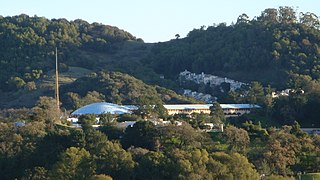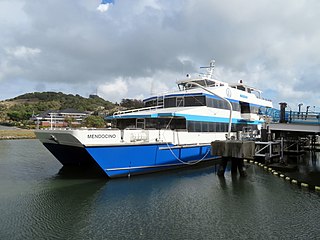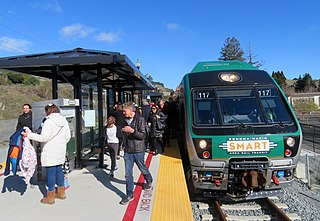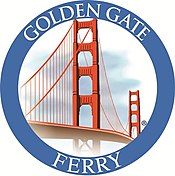
Marin County is a county located in the northwestern part of the San Francisco Bay Area of the U.S. state of California. As of the 2020 census, the population was 262,231. Its county seat and largest city is San Rafael. Marin County is across the Golden Gate Bridge from San Francisco, and is included in the San Francisco–Oakland–Berkeley, CA Metropolitan Statistical Area.

The Richmond–San Rafael Bridge is the northernmost of the east–west crossings of the San Francisco Bay in California, USA. Officially named after California State Senator John F. McCarthy, it bridges Interstate 580 from Richmond on the east to San Rafael on the west. It opened in 1956, replacing ferry service by the Richmond–San Rafael Ferry Company.

Golden Gate Transit (GGT) is a public transportation system serving the North Bay region of the San Francisco Bay Area in California, United States. It primarily serves Marin County, Sonoma County, and San Francisco, and also provides limited service to Contra Costa County. In 2022, Golden Gate Transit had a ridership of 1,205,100, or about 3,900 per weekday as of the fourth quarter of 2022.

The North Bay is a subregion of the San Francisco Bay Area, in California, United States. The largest city is Santa Rosa, which is the fifth-largest city in the Bay Area. It is the location of the Napa and Sonoma wine regions, and is the least populous and least urbanized part of the Bay Area. It consists of Marin, Napa, Solano and Sonoma counties.

Sonoma–Marin Area Rail Transit (SMART) is a rail line and bicycle-pedestrian pathway project in Sonoma and Marin counties of the U.S. state of California. When completed, the entire system will serve a 70-mile (110 km) corridor between Cloverdale in northern Sonoma County and Larkspur Landing in Marin County. In 2022, the system had a ridership of 474,500, or about 2,200 per weekday as of the fourth quarter of 2022.

The Golden Gate Bridge, Highway and Transportation District is a special-purpose district that owns and operates three regional transportation assets in the San Francisco Bay Area: the iconic Golden Gate Bridge, the Golden Gate Ferry system and the Golden Gate Transit system. All three assets connect Marin County with San Francisco.

The “Northwestern Pacific Railroad” was a 271 mile mainline railroad from the ferry connections in Sausalito north to Eureka with a connection to the national railroad system at Schellville. The railroad has gone through a history of different ownership and operators but has maintained a generic name of reference as “The Northwestern Pacific.” Currently, only a 62-mile (100 km) stretch of mainline on the “South End” is operated by Sonoma-Marin Area Rail Transit (SMART), which operates both commuter and freight trains with plans for future extension north to Cloverdale. The “North End,” from Willits to Eureka which includes connections to the California Western Railroad] is currently out of service but saved by 2018 legislation to be converted into the Great Redwood Trail.

People in the San Francisco Bay Area rely on a complex multimodal transportation infrastructure consisting of roads, bridges, highways, rail, tunnels, airports, seaports, and bike and pedestrian paths. The development, maintenance, and operation of these different modes of transportation are overseen by various agencies, including the California Department of Transportation (Caltrans), the Association of Bay Area Governments, San Francisco Municipal Transportation Agency, and the Metropolitan Transportation Commission. These and other organizations collectively manage several interstate highways and state routes, eight passenger rail networks, eight trans-bay bridges, transbay ferry service, local and transbay bus service, three international airports, and an extensive network of roads, tunnels, and bike paths.

Spare the Air is a program established by the Bay Area Air Quality Management District in 1991 to combat air pollution during the summer in the San Francisco Bay Area, the season when clear skies, hot temperatures, lighter winds, and a strong temperature inversion combine and trap air pollutants near the ground.

San Francisco Bay in California has been served by ferries of all types for over 150 years. John Reed established a sailboat ferry service in 1826. Although the construction of the Golden Gate Bridge and the San Francisco–Oakland Bay Bridge led to the decline in the importance of most ferries, some are still in use today for both commuters and tourists.

Blue & Gold Fleet is a privately owned company in the United States providing ferry services in the San Francisco Bay Area of California. It operates the San Francisco Bay Ferry commuter ferry system under contract with WETA. Blue & Gold also operates tourist and excursion services under its own brand from Pier 41 in San Francisco, with midday ferry service to Sausalito and a variety of tourist routes. The company is the Bay Area's largest ferry transportation provider and carries approximately 4 million passengers annually.

San Francisco Bay Ferry is a public transit passenger ferry service in the San Francisco Bay, administered by the San Francisco Bay Area Water Emergency Transportation Authority (WETA). In 2022, the system had a ridership of 1,787,400, or about 4,500 per weekday as of the fourth quarter of 2022.

Larkspur Landing, also known as Larkspur Ferry Terminal, is the main Golden Gate Ferry terminal in Larkspur, California, in Marin County, north of San Francisco. The terminal is a regional hub receiving heavy service from throughout the North Bay for commuter ferries south to downtown San Francisco.

The San Rafael Transportation Center is an intermodal transportation center located in downtown San Rafael, California. It is a primary transfer point for several local and regional bus operators, and a commuter rail station on the Sonoma–Marin Area Rail Transit (SMART) system.

The M/V Mendocino is a passenger-only fast ferry operated by Golden Gate Ferries.

The Tiburon Ferry Terminal is a ferry landing for Golden Gate Ferry and Angel Island–Tiburon Ferry Company passenger ferries in Tiburon, California in the San Francisco Bay Area's North Bay. It connects commuters from Marin County with job centers in San Francisco across the San Francisco Bay to the Ferry Building. The terminal also provides tourist and recreational passenger service to the Ayala Cove Ferry Terminal on Angel Island State Park.

Larkspur station is a Sonoma–Marin Area Rail Transit (SMART) station in Larkspur, California. The terminal station opened to revenue service on December 14, 2019. It is located 1⁄3 mile (0.5 km) from the Larkspur Landing ferry terminal, across Sir Francis Drake Boulevard.

Sausalito Ferry Terminal is a ferry terminal in Sausalito, California, connecting Marin County and San Francisco. The station is served by Golden Gate Ferry and Blue & Gold Fleet ferries as well as Golden Gate Transit and Marin Transit bus routes.
Golden Gate Ferry Company was a private company which operated automobile ferries between San Francisco, Berkeley and Sausalito before the opening of the Bay Bridge and the Golden Gate Bridge. The company was incorporated in November 1920. The ferry went bankrupt at the completion of the Golden Gate Bridge, but with the start of World War 2 the demand for service was so great it started again. Ferry service started just one year after closing to ferry shipyard workers to the Marinship and Kaiser Shipyards shipyard in San Francisco. But after the war, service was discontinued again. In early 1929, the Golden Gate Ferry Company merged with the ferry system of the Southern Pacific railroad, becoming the Southern Pacific-Golden Gate Ferries, Ltd.

The Northwestern Pacific Railroad operated a network of electric interurban lines in Marin County, California from 1903 to 1941. The lines ran to Sausalito at the southern tip of the county, where connecting ferries ran to San Francisco. Trains consisted of electric multiple units powered by third rail electrification. The lines were the first third-rail electrification in California, and the first major railroad to use alternating current signals.






















